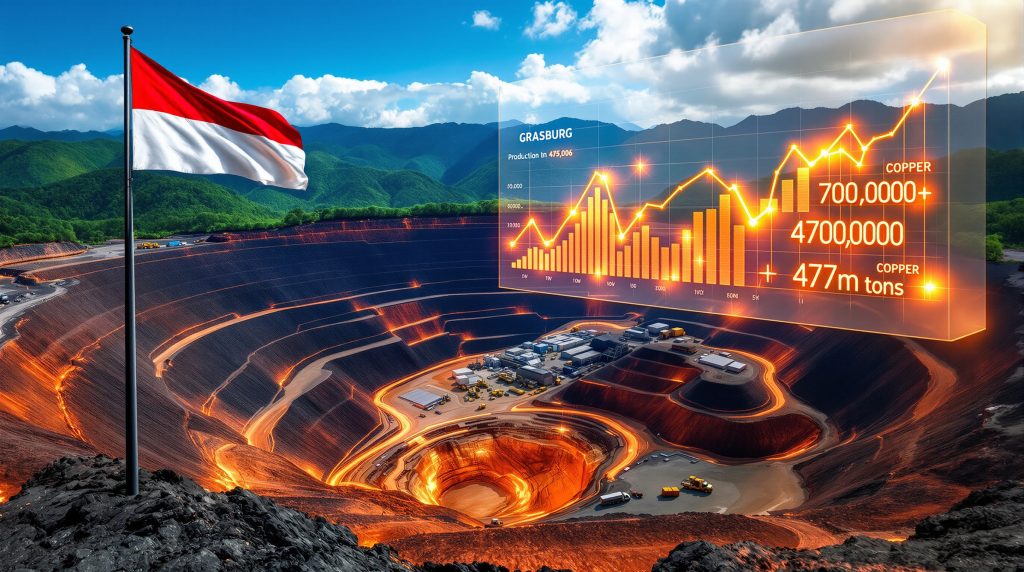Global Copper Supply Vulnerabilities Expose Mining Sector's Operational Fragility
The mining industry's reliance on complex underground operations continues to demonstrate inherent systemic risks that reverberate across global commodity markets. When geological instability intersects with high-production mining systems, the resulting supply disruptions create cascading effects that extend far beyond individual operational boundaries. This dynamic has become particularly evident in Southeast Asian copper production, where tropical environments present unique challenges to large-scale extraction operations.
Indonesia's position as a critical supplier in global copper markets has intensified scrutiny of operational resilience across the region's mining infrastructure. The intersection of technical complexity, environmental factors, and market dependency creates scenarios where localised incidents can trigger significant commodity price movements and supply chain reallocations.
Understanding these vulnerability patterns requires examining both immediate operational impacts and longer-term strategic adaptations that mining companies must implement to maintain market stability. The mining sector's response to production disruptions reveals crucial insights into supply chain elasticity and the financial mechanisms companies employ to navigate unexpected operational challenges.
Production Disruptions Signal Broader Market Adjustment Period
When Freeport Indonesia cuts 2026 output plan by over 220,000 metric tons of copper cathode, the implications extend beyond a single company's operational challenges. This reduction represents a 31.7% decrease from initially planned production levels of 700,000 metric tons to a revised target of 478,000 metric tons. The simultaneous gold production cut of 19 tons (from 45 to 26 tons) compounds the supply chain impact across multiple precious metals markets.
The financial resilience demonstrated by maintaining revenue projections near original levels despite dramatic production cuts reveals sophisticated commodity price modelling. Revenue projections declining only 2.4% (from $8.5 billion to $8.3 billion) while copper production drops by nearly one-third indicates significant reliance on price appreciation assumptions.
| Production Metric | Original 2026 Plan | Revised 2026 Plan | Reduction |
|---|---|---|---|
| Copper Cathode (metric tons) | 700,000 | 478,000 | 222,000 (32%) |
| Gold Production (tons) | 45 | 26 | 19 (42%) |
| Revenue Projection | $8.5B | $8.3B | $200M (2.4%) |
The market's ability to absorb this production shortfall depends heavily on alternative sourcing capabilities and existing inventory levels across major consumer markets. Current copper price insights with positive momentum suggests market conditions may support the revenue assumptions underlying these projections.
Supply Chain Rebalancing Accelerates Alternative Sourcing
The geographic concentration of copper production in politically and geologically volatile regions creates systematic supply chain vulnerabilities that extend beyond single-mine disruptions. Indonesia's domestic processing mandates further complicate global supply chains by requiring local smelting capacity rather than permitting raw ore exports.
Major copper consumers must now evaluate the global copper supply forecast alongside several critical factors. These include regional smelter capacity constraints that limit processing alternatives, transportation logistics for alternative concentrate sources, quality specifications matching requirements for downstream applications, and long-term contract implications with reduced Indonesian supply availability.
The Grasberg complex's role as the world's second-largest copper mine and largest gold mine amplifies these concerns. When a facility accounting for more than 25% of Freeport's total output experiences extended disruptions, global copper market dynamics shift significantly.
Technical Recovery Challenges Define Timeline Expectations
The September 2025 mudflow incident at Grasberg Block Cave that resulted in seven fatalities exposed critical vulnerabilities in tropical underground mining operations. Furthermore, this deadly accident demonstrated how compartmentalised mining zones can experience vastly different risk profiles within the same complex.
Big Gossan and Deep Mill Level Zone operations resumed in late October 2025, indicating their geological isolation from the mudflow incident. This operational segmentation allows partial production continuity while the primary Block Cave operation undergoes extensive remediation.
Recovery Timeline Analysis
The staged recovery approach reflects the technical complexity of addressing mudflow damage in underground block cave operations. The recovery process involves comprehensive ground stability assessment, structural reinforcement, and enhanced water management systems:
- Q4 2025: Big Gossan and Deep MLZ continued operations
- Q1 2026: Grasberg Block Cave partial operations restart target
- Q2 2026: Large-scale production restoration planned
- 2027: Full production capacity recovery expected
This 18-month recovery trajectory from incident to full capacity restoration highlights the engineering challenges associated with tropical underground mining environments. Block cave mining methodology requires precise geological stability management, particularly in high-precipitation tropical regions where groundwater infiltration can create mudflow conditions.
The remediation process involves comprehensive ground stability assessment, structural reinforcement, and enhanced water management systems before operations can safely resume. CEO Tony Wenas's statements indicate ongoing engineering assessments with conservative restart timelines prioritising worker safety over production acceleration.
Geological Risk Assessment in Tropical Mining
Indonesia's tropical climate presents specific challenges for underground mining operations that extend beyond the Grasberg complex. Additionally, modern copper mining innovation offers potential solutions to these environmental challenges. High annual precipitation, groundwater saturation, and weathering patterns in tropical environments create conditions where mudflow incidents become more probable.
The compartmentalised impact at Grasberg (affecting only Block Cave while sparing adjacent operations) suggests that geological risk assessment and mine design can mitigate some tropical environment hazards through proper engineering approaches.
Key tropical mining risk factors include:
- Hydrogeological instability from excessive groundwater infiltration
- Structural degradation accelerated by tropical weathering patterns
- Seasonal precipitation variations creating cyclical stability challenges
- Ground support system corrosion in humid tropical conditions
Strategic Partnership Development Addresses Supply Gaps
Ongoing negotiations between Freeport and Amman Mineral Internasional for copper concentrate supply represent a strategic response to production shortfalls that could reshape Indonesian copper processing dynamics. These discussions indicate Freeport's recognition that internal production alone cannot support optimal smelter utilisation during the recovery period.
The PT Smelting refinery currently processes Freeport's reduced concentrate output while the Manyar smelter remains idle until anticipated Q2 2026 recommissioning. This smelter capacity imbalance creates economic incentives for external concentrate sourcing partnerships.
Smelter Optimisation Strategies
Indonesian domestic processing requirements create unique dynamics where smelter capacity must be maintained through external concentrate sourcing when internal mine production falls short. However, the mining industry evolution suggests that companies are developing more resilient operational frameworks. The Manyar smelter's planned Q2 2026 restart coincides with Freeport's recovery timeline, potentially creating demand for additional concentrate supplies beyond internal production.
Strategic considerations include:
- Concentrate quality specifications matching smelter technical requirements
- Transportation logistics for alternative concentrate sources within Indonesia
- Processing cost economics compared to international smelting alternatives
- Long-term supply agreements providing operational stability during recovery
The absence of a finalised agreement with Amman Mineral Internasional suggests ongoing negotiations around pricing mechanisms, delivery terms, and supply volume commitments that align with Freeport's production recovery timeline.
Revenue Resilience Through Commodity Price Leverage
When Freeport Indonesia cuts 2026 output plan, the company's ability to maintain $8.3 billion revenue projections despite production cuts of 222,000 metric tons of copper and 19 tons of gold demonstrates significant financial leverage to commodity price movements. This revenue stability amid volume reductions relies entirely on copper and gold price appreciation assumptions.
2025 performance metrics illustrate this price-volume relationship:
- Copper sales volume: 30% reduction from initial plans
- Gold sales volume: 50% reduction from initial plans
- Revenue decline: Only 18% despite significant volume reductions
The 12-percentage-point gap between volume reduction (30%) and revenue decline (18%) explicitly demonstrates price compensation offsetting production shortfalls.
Commodity Price Assumption Analysis
Current market conditions with copper at $5.0527 per pound and gold futures at $4,074.4 per troy ounce provide baseline pricing for revenue projection models. However, the sustainability of revenue targets depends on continued price appreciation that may not materialise consistently.
Consequently, price sensitivity scenarios include sustained price appreciation where revenue targets become achievable with current volume reductions, price volatility cycles creating revenue fluctuations requiring operational flexibility, and price decline scenarios causing potential revenue shortfalls necessitating further cost reductions.
The concentration of revenue assumptions on commodity price performance creates significant financial risk exposure that extends beyond operational recovery challenges.
Indonesian Mining Policy Implications Extend Beyond Single Operations
The Grasberg incident occurs within Indonesia's broader strategy of domestic processing mandate enforcement and resource nationalism acceleration. Furthermore, potential copper trade war impact adds another layer of complexity to Indonesia's mining policy framework. These policy directions create structural changes in how international mining companies operate within Indonesian jurisdiction.
Strategic mineral export controls increasingly require local processing capacity rather than permitting raw material exports. This regulatory environment forces mining companies to invest in domestic smelting infrastructure and maintain processing capacity even during production disruptions.
Infrastructure Development Priorities
Indonesia's mining policy evolution emphasises smelter capacity expansion requirements for major mining operations, transportation network resilience supporting domestic processing, energy security provisions for mining and smelting operations, and foreign investment framework modifications prioritising domestic value addition.
These policy directions create both challenges and opportunities for companies like Freeport that maintain significant Indonesian operations. In addition, compliance requirements may increase operational complexity but also provide regulatory predictability for long-term investment planning.
Global Copper Project Economics Shift Due to Indonesian Supply Disruptions
Reduced Indonesian copper output creates market opportunities for competing projects worldwide that can accelerate development timelines or expand existing production capacity. Projects with shorter development cycles or established infrastructure may capture market share during Grasberg's recovery period.
Regional supply rebalancing effects include:
- South American copper projects experiencing improved economics from higher prices
- African copper development receiving increased investment interest
- Australian expansion projects gaining viability through market tightening
Investment capital allocation may shift toward projects offering faster production timelines and lower geological risk profiles compared to complex tropical underground operations.
Alternative Copper Exposure Strategies
For investors seeking copper market exposure while managing operational risk, the Grasberg situation highlights the importance of geographic and technological diversification. Open-pit operations in stable geological environments may receive premium valuations compared to complex underground operations in challenging climates.
Diversification strategies include:
- Multiple jurisdiction exposure reducing single-country political risk
- Varied mining methodologies balancing open-pit and underground operations
- Different commodity mixes providing revenue stability through precious metals co-production
- Operational scale diversity combining large-scale and smaller, more flexible operations
Technology Solutions Address Tropical Mining Challenges
When Freeport Indonesia cuts 2026 output plan following the Grasberg mudflow incident, it emphasises the critical need for advanced geological monitoring systems in tropical underground mining environments. Real-time stability tracking technology could provide early warning systems preventing similar incidents.
Emerging monitoring technologies include:
- Continuous ground stability sensors detecting geological movement patterns
- Hydrogeological monitoring networks tracking groundwater infiltration risks
- Automated alert systems providing real-time hazard notifications
- Remote operation capabilities reducing worker exposure to high-risk zones
Automation Investment Priorities
The fatal accident at Grasberg demonstrates how worker safety enhancement through technology becomes both an operational necessity and regulatory requirement. Automation technologies can maintain production consistency while reducing human exposure to geological hazards.
Investment priorities include:
- Remote-controlled equipment operating in high-risk geological zones
- Automated material handling systems reducing worker presence underground
- Predictive maintenance programmes preventing equipment failures in challenging environments
- Digital twin modelling enabling operational simulation before physical implementation
Market Adaptation Timeline Reflects Structural Supply Changes
Global copper supply chains require 12-18 months to fully adapt to major production disruptions like those at Grasberg. However, recent analysis indicates that Freeport targets 2026 restart which provides more clarity on recovery timelines. This adaptation period involves inventory adjustments, alternative sourcing arrangements, and pricing mechanism recalibration.
Short-term market adjustments (2025-2026) focus on immediate supply gap management through existing inventory utilisation by major industrial consumers, alternative supplier engagement for immediate copper cathode requirements, and spot market pricing volatility reflecting supply uncertainty.
Medium-term supply rebalancing (2026-2028) involves alternative project acceleration filling sustained supply gaps, long-term contract renegotiation reflecting new supply realities, and smelter capacity optimisation across multiple regional facilities.
Strategic Reserve Implications
Government and industrial strategic reserve policies may require adjustment to account for increased supply chain vulnerability from key producing regions. The Grasberg disruption demonstrates how single-mine incidents can affect global market balance.
Reserve management strategies include:
- Government stockpiling programmes providing emergency supply security
- Industrial buyer inventory expansion reducing short-term supply risk
- Regional supply diversification decreasing dependence on single-source suppliers
- Emergency supply protocol development enabling rapid response to future disruptions
Disclaimer: This analysis involves forecasts and speculation about commodity markets, mining operations, and recovery timelines. Actual outcomes may differ significantly from projections due to geological, operational, regulatory, or market factors. Investors should conduct independent research and consider professional advice before making investment decisions related to mining companies or commodity markets.
Looking for Copper Market Opportunities Following Supply Disruptions?
Discovery Alert's proprietary Discovery IQ model delivers real-time notifications on significant ASX mineral discoveries, including copper exploration breakthroughs that could benefit from current supply constraints affecting major producers. Start your 30-day free trial today and position yourself ahead of market movements that respond to global supply chain vulnerabilities.




